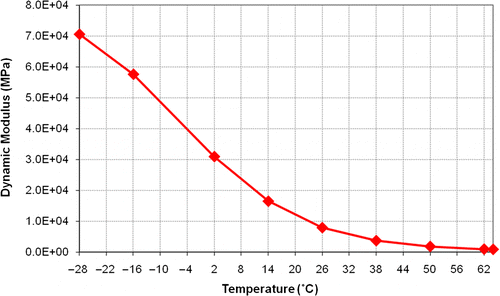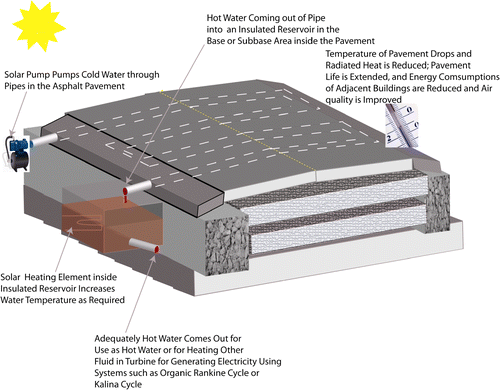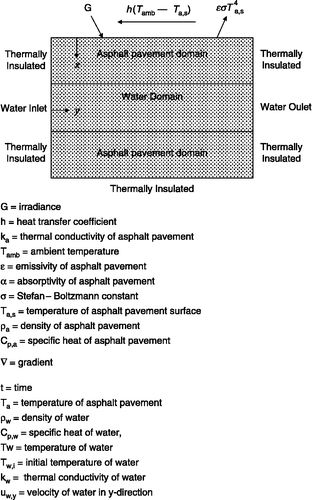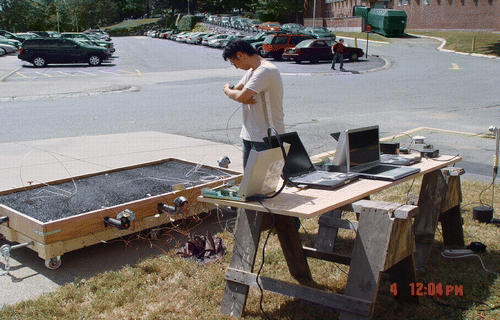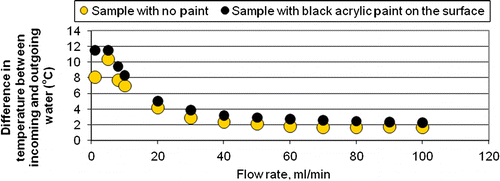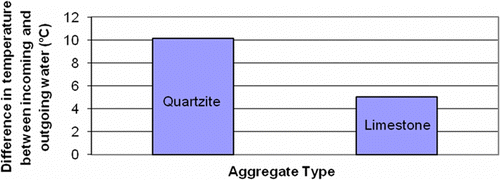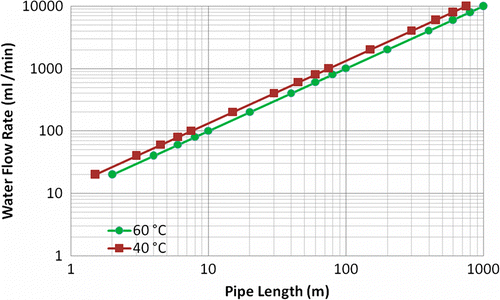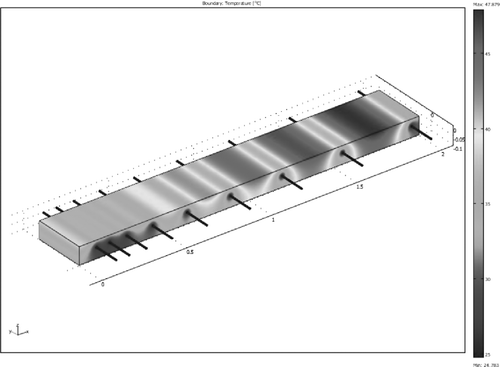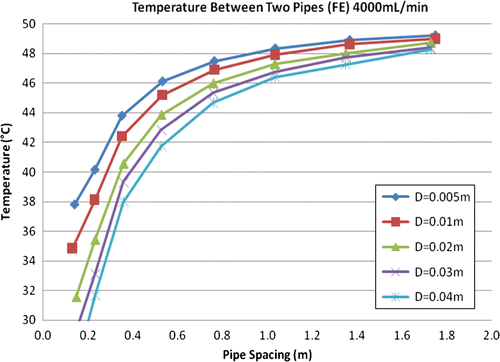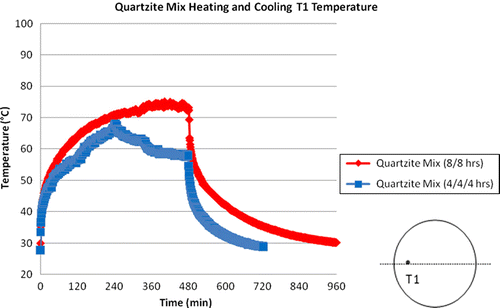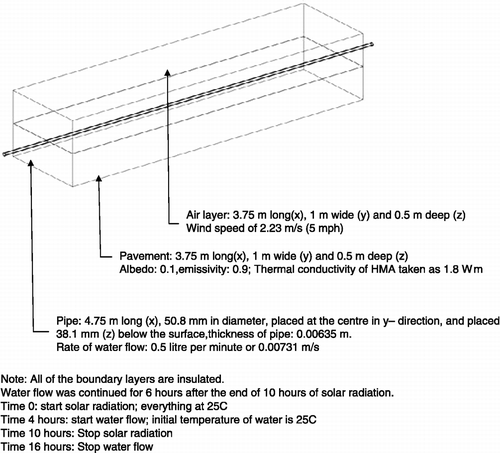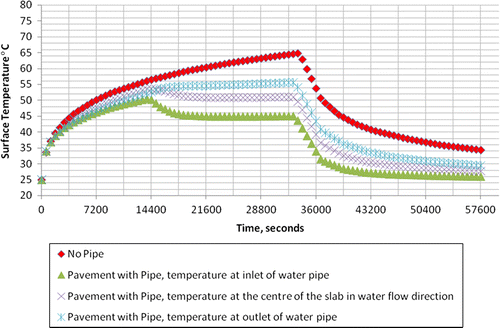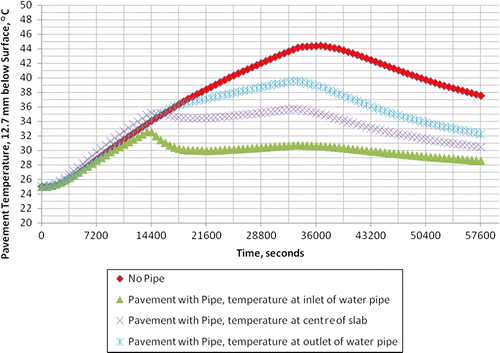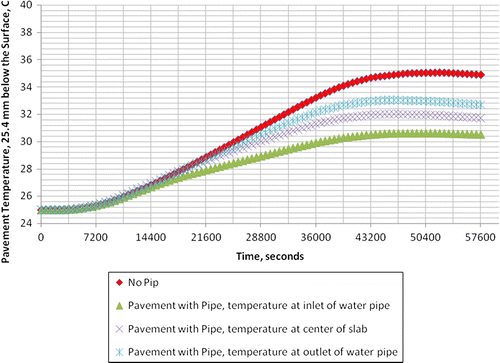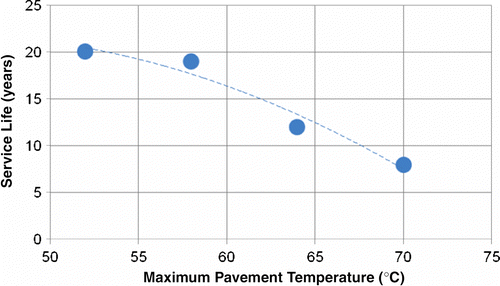Abstract
A rise in temperature of asphalt pavements contributes towards the urban heat island effect, causes problems with air quality and increases the power requirement for cooling buildings. A high temperature would also lead to the potential of rutting failure in asphalt pavements. The concept of mining heat from asphalt pavements, utilising an appropriate fluid flowing in pipes installed within the pavement, has been proposed. Theoretical considerations and results of laboratory testing and modelling simulation have been presented. The results indicate that the concept is feasible, and that the efficiency of heat mining can be improved by selecting appropriate surface layer and aggregates for pavement materials. The use of this proposed method would lead to a significant reduction in pavement and near-surface air temperature, and extension of asphalt pavement life.
Keywords:
1. Introduction
Solar radiation causes an increase in the temperature of asphalt pavements, which consist of asphalt binder and mineral aggregates – both of which have relatively low conductivities. Because of the dark colour of the surface, asphalt pavements soak in a large amount of heat and, in turn, radiate the heat back to the environment, thus contributing to the urban heat island (UHI) effect. Examples of high pavement surface temperatures in a few selected cities in the USA are shown in Table .
Table 1 Maximum temperature of the asphalt pavement surface.
Furthermore, in several areas, the pavement temperature remains high for a significant period of time during the summer months, as shown in Figure , for example, for Houston.
Figure 1 Maximum temperature of a 2-day period in August at different depths of an asphalt pavement in Houston, TX.
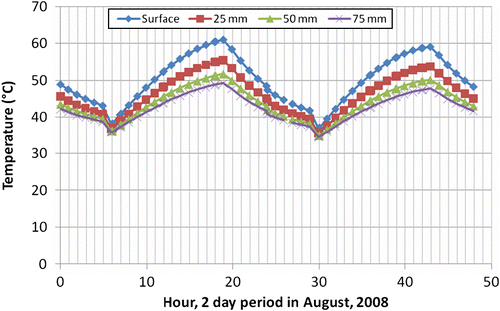
The high temperatures of the asphalt pavements have significant impact on the environment. The radiated heat from the pavement results in an increase in the temperature of the near-surface air, which leads to an increase in power consumption of buildings adjacent to pavements (for cooling) and a deterioration of the air quality (rise in ozone concentration). Furthermore, the increased temperature of the asphalt pavement leads to a reduction in the stiffness (which is temperature dependent) of the pavement, and hence makes it more susceptible to permanent deformation failures under traffic.
A rise in air temperature leads to an increase in energy and water consumption, and indirectly contributes to the formation of smog and ozone production, which leads to significant health concern (Akbari Citation1995, Gray and Finster Citation2000). Studies have shown that cooling of cities by 3°C can reduce smog by 12% and result in savings of tens of millions of dollars (Akbari Citation1995, Akbari et al. Citation1996). With the potential for the doubling of the human population in the next five decades, and the resultant increase in the percentage of the population living in urban areas (up to maybe 80%), unmodified UHI effects have the potential to significantly impact sustainability (Crutzen Citation2004). The extent of the problem is significant since more and more pavements are being constructed, and it has been stated that the added volumes of pavements make up 29–45% of the urban area (e.g. 29% in Houston and 45% in Sacramento; Golden Citation2004, Cambridge Systematics, Inc. Citation2005). A large portion of this is due to parking; in the Houston metropolitan area, the parking facilities account for approximately 60% of the transportation land use. The predominant surface type in pavements is asphalt (Cambridge Systematics, Inc. Citation2005).
Because of the presence of the asphalt binder, asphalt pavement material (or mixture, mix) behaves as a viscoelastic material. It exhibits higher stiffness at lower temperatures and relatively lower stiffness at higher temperatures (see Figure as an example). Consequently, the potential of shear stress-related deformation (rutting) increases at higher temperatures. Rutting is one of the most important distresses in asphalt pavements.
For the asphalt mix part, the plastic strain is basically modelled as follows (NCHRP Citation2004):
1.1 Proposed solution
The rate of energy emitted by an ideal surface (black body) with emissivity equal to 1 is given by the Stefan–Boltzmann law (Schmidt et al. Citation1993):
The net emitted radiation intensity from the pavement surface to its surroundings is calculated as
The emissivity of a material ϵ is the ratio of energy radiated by the material to energy radiated by a black body at the same temperature. It is a measure of a material's ability to absorb and radiate energy. A true black body would have the value of ϵ = 1 while any real object would have ϵ < 1. Emissivity depends on factors such as temperature, emission angle and wavelength.
Based on the Stefan–Boltzmann law, the variable that would reduce the back-radiated energy is the temperature difference between the asphalt pavement surface and the surrounding temperature.
Hence, one possible way of cutting down the UHI effect and reducing the rutting potential of the pavement is through the reduction in pavement temperature by mining the heat energy by flowing an appropriate fluid through a network of pipes under the pavement. The temperature of the asphalt pavement surface can be reduced, while the heated fluid may be used for different end applications such as heating, power generation or chillers. The reduced temperature will lead to a relatively higher stiffness of the asphalt pavement, specifically in hot climatic conditions, and will reduce or prevent deformation, and hence extend the life of the pavement.
The amount of heat energy that can be mined from a pavement can be estimated as follows. For a radiation of 5 kWh/m2/day (solar radiation data are available from http://www.nrel.gov/, National Renewable Energy Laboratory) and a parking lot of 45 × 45 m, the total energy available to us is (5) × (45 × 45) = 10,125 kWh/day. If the efficiency of the pavement heat exchanger system is considered to be 15%, then the heat energy that can be harvested is 10,125 × 0.15 = 1518 kWh/day.
2. Results of the study
This paper presents the concept of using a piping network below the surface of asphalt pavements to flow an appropriate fluid, to reduce the temperature of the asphalt pavement, reduce UHI effect and use the heated fluid for different end applications such as heating, power generation or refrigeration (Figure ). The results of theoretical and laboratory-scale experimental work are presented.
2.1 Theoretical considerations
Our approach has been to study the coupled asphalt pavement–water system. The problem is illustrated in Figure . The heat transfer problem is a coupled conduction–convection–radiation problem with appropriate boundary conditions at the pavement–air and pavement–water interface. The problem has two domains: the asphalt mix domain, where the transient conduction heat equation is solved, and the water domain, where the convective terms play an important role. The mean water velocity is obtained from the conservation of mass. Appropriate values for boundary conditions were used.
Boundary condition on the surface of the asphalt pavement
Governing equation (asphalt domain)
Governing equation (water domain)
Boundary condition (interface between asphalt pavement and water)
Boundary condition (water inlet)
Boundary condition (water outlet)
Boundary condition of the asphalt pavement below the pipe:
2.2 Experimental work
After confirmation of transfer of heat from a heated asphalt pavement sample to water with finite element (FE) modelling (Figure ), laboratory experiments were carried out using compacted hot mix asphalt (HMA) samples with different types of aggregates to evaluate the feasibility of the proposed concept.
The test set-up consists of a thermocouple-instrumented asphalt mix sample, subjected to radiation from a halogen lamp (Figure , details in Mallick et al. Citation2008). Pipes with different surface areas were used to flow water through the samples, and the difference between the incoming and outgoing water temperature was used as an indication of the efficiency of heat harvesting. Experiments were also carried out using natural solar light, with instrumented large-scale slabs (Figure ).
Figure 6 Test set-up (note: thermocouples from Cole-Parmer, Type K (chromel–alumel) thermocouple, − 250 to +482°C temperature range. Response time is 15 s and sensitivity is approximately 41 μV/°C. Data acquisition system: National Instruments SC-2345 Series. Software: LabView 8.1.)
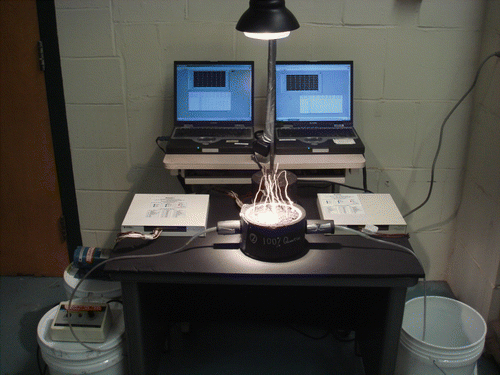
The results clearly showed the feasibility of the proposed method, and indicated the beneficial effects of higher thermal conductivity of aggregates and larger surface area of pipes. It was concluded that two steps can be taken to improve the amount of heat that can be harvested from asphalt pavements.
-
The surface of the pavement can be painted with a reflectivity decreasing/absorptivity increasing paint, such as black sealer. This will increase the amount of energy that is trapped inside the pavement. Laboratory results show that the use of black acrylic paint can increase the difference between incoming and outgoing water (through asphalt pavement) by almost 50% (Figure ). Instead of acrylic paint, commercially available pavement sealers such as coal tar pitch, coal tar blend or asphalt emulsions could be used. Studies conducted by Washington Department of Transportation (WSDOT Citation2007) indicate that the lifespan of these sealers ranges from 4 to 10 years. It is expected that the pavement surface would be sealed every 4–6 years to prevent damage to the material. For the proposed application, the effect of the deterioration of the sealer/sealed surface will be in terms of reduced emissivity, say for example, from 0.91 to 0.85. However, because of the asphalt binder of the HMA, the emissivity value will remain at a fairly high number (say, above 0.8).
-
The thermal conductivity of the pavement mix can be improved by using aggregates with higher thermal conductivity, such as quartzite (containing high percentage, >90%, of quartz). Laboratory test results show that the difference between incoming and outgoing water (through asphalt pavement) was increased by 100% by replacing limestone aggregates with quartzite aggregates (Figure ). Note that even a relatively thin layer of quartzite could be used around the pipes for better conduction. In places where such aggregates are not available, improvement in conduction could be achieved with the use of high conductivity planar materials, such as graphite sheets.
-
The depth of the heat exchanger system is critical for maximum harvesting of heat energy from pavements.
2.3 Theoretical considerations for minimum pipe length and spacing required for the water to reach the pavement temperature
A minimum length of the pipe is required for the water to reach the pavement temperature at the depth of the pipe. This value depends on the rate of flow. Plots of water temperature versus pipe lengths for different flow rates are shown in Figure . The water/fluid carrying pipes must be placed at a minimum spacing such that there is no low temperature or ‘cool’ spot formation between the pipes (Figure ; although a closer spacing is more efficient for reducing the temperature of the pavement). Based on FE modelling, Figure was developed. Note that for a specific flow rate, there is a minimum spacing, depending on the diameter of the pipe.
3. Environmental and energy benefits from the proposed system
Apart from the harvesting of energy from the asphalt pavements, the benefits from this concept can be realised in two more ways through the reduction in near-surface air temperature:
-
reduction in power consumption of adjacent buildings and
-
improvement in air quality.
The following paragraphs present the summary of results of experiments and analysis conducted to quantify the above parameters.
3.1 Reduction in surface temperature
3.1.1 Experimental work
Based on the Stefan–Boltzmann law, the variable that would reduce the back-radiated energy is the temperature difference between the asphalt pavement surface and ambient temperature (air). The hypothesis of this study is that the surface temperature of the asphalt pavement will be reduced due to the convective heat transfer of water flowing underneath it, which will decrease the back-radiated energy emitted from the asphalt pavement to the air.
To evaluate this concept, first, the surface temperatures of asphalt mix samples with and without flowing water (in pipes inside samples) were obtained (details in CitationChen et al. in press). The samples were subjected to radiation from a halogen lamp, as described earlier in this paper. Figure shows a schematic of the thermocouple locations on the sample, and Figure shows an example plot of the results of the surface temperature measurements at different locations on the samples with and without flowing water. Table shows the reduction in surface temperature at the location of the different thermocouples. These results clearly indicate that a lower temperature can be achieved at the surface of the pavement at locations directly above the pipe by flowing water.
Table 2 Average reduction in surface temperature due to flowing water.
3.1.2 Finite element analysis
A pavement made of HMA was modelled, along with an air layer on top of it. In one case, a pipe was placed below the surface (surface to top of the pipe), and in another case, a pavement without any pipe was modelled (Figure ).
The heat transfer coefficient on the surface of the asphalt pavement was calculated based on different wind speeds by using Vehrencamp (Citation1953),
Based on an average 2.23 m/s wind speed, the air layer thickness (thermal boundary layer) that would be affected (pure conduction) by the surface temperature of the asphalt pavement was 0.05 m. The air layer in the model was used as 0.5 m to simulate the infinite distance (thickness) so that the top of the air layer would not be affected by the surface temperature of the asphalt pavement.
Figure shows the plots of surface temperature versus time. The minimum reduction in the surface temperature due to water flow in the pipe is 10°C (at the outlet), while the maximum is 20°C (at the water inlet).
Figure shows the plots of radiative flux from the pavement surface versus time. This was obtained by integrating the radiative flux across the pavement surface and dividing the total radiation by the area of the pavement surface. Starting at the time of the start of water flow, there is a steady drop of radiative flux of approximately 25 W/m2 (for an incident radiation of 800 W/m2).
The plots of near-surface air temperature versus time are shown in Figure . Note that these temperatures were obtained for a height of 0.1 m from the pavement surface, and because of modelling limitations (the air layer was considered as 0.5 m thick), the absolute numbers of the temperatures are not valid. However, relative to a conventional pavement, the reduction in air temperature for a pavement with water flowing pipes is clearly visible in Figure .
The temperatures of the pavements 12.7 mm below the surface are shown in Figure . Again, a clear drop in temperature is noted. The temperature is reduced from a minimum of 10°C (at the outlet) to a maximum of 15°C (at the inlet).
Figure shows the plots for the temperature of the pavement 25.4 mm below the surface, and a reduction in temperature of approximately 2–4°C is noted.
3.2 Effect of reduction in air temperature over energy consumption and air quality
The effect of the reduction in the near-surface air temperature on the energy consumption and air quality can be evaluated with the UHI Mitigation Impact Screening Tool (MIST; http://www.heatislandmitigationtool.com/Inputs.aspx?t = 1, Sailor and Dietsch Citation2005). The maximum allowable temperature reduction in the tool is 5°F. With a 5°F reduction, for example, in Houston, savings in energy consumption and reduction in 1 h/8 h ozone concentration can be achieved (Table ). For post-1980 buildings, the savings in energy consumption for electricity-heated residential, office and retail buildings are 22, 11 and 13%, respectively. The reductions in ozone concentration are 3.4–5.6 and 2.5–4.2 ppb, for 1 and 8 h values.
Table 3 Effect of reduction in 5°F air temperature on energy consumption and 1 h/8 h ozone concentration (from MIST).
3.3 Application areas for the proposed concept and extension of pavement life with this concept
Any asphalt pavement is suitable for the proposed application, particularly in regions with a good amount of solar radiation, that creates high pavement temperatures for a significant amount of time during the year. Note that the feasibility of this application needs to be checked against two considerations: what is the benefit and what is the cost of the application. A ‘good’ site will be one for which the energy gain/benefits and costs are such that positive cash flow from the project can be expected within a relatively short period of time, say 5–8 years. Because of high speeds and heavy loads, placement of a piping network directly beneath traffic lanes in highways could be complicated, although such a network could be installed on the shoulders. Car parking lots with adjacent buildings would be ideal for such an application. In a typical office parking lot, probably close to 100% of the area is available for work areas on weekends and recreational or church areas on weekdays. Conversely, approximately 45% of the area is available in work areas on weekdays and church or recreational areas on weekends. For example, Figure shows that approximately 45% of the area in the parking lot on a weekday (for a university parking lot) is at relatively high temperature.
3.4 Effect on pavement life
One motivation for the use of such a concept in high traffic/slow traffic areas (such as intersections) and high temperature could be that a lower temperature of the pavement would result in a higher resistance against permanent deformation or rutting potential. The NCHRP 1-37A mechanistic empirical pavement design (MEPDS, commonly referred to as the Design Guide 2002, or DG2002, NCHRP Citation2004) software is a Windows-based application for the simulation of pavement structures. It can be used to simulate pavement structures under different traffic and climatic conditions. The software has the ability to predict the amount of damage that a structure will display at the end of its simulated design life. In addition to using laboratory test results, predicting properties for pavement mixes can be done by using correlations. Values (either default or entered by the user) that represent structural, climatic or traffic properties are used in calculating distresses.
The software can be used for predicting the rutting damage over different years, considering the usual pavement temperature and then a range of temperatures that are lower than the usual temperature. To do this, the weather database in the MEPDS can be utilised. An example of calculation of years to failure (or service life) is shown below. For this example, four cities were selected to consider a range of maximum pavement temperatures, from 70 to 52°C. These are, in decreasing temperatures, Houston, Raleigh-Durham, Chicago and Portland (ME). A pavement located in Houston was simulated, using the climatic information for the above four cities, to determine the rutting damage over the years, and the years to failure, for the range of temperatures (70–52°C). The results are shown in Figure . It can be seen that, for the same traffic and the same materials, the life of the pavement can be extended by 5 years for a drop in temperature of 5°C. The drop in temperature is more effective in extending the life of the pavement at higher temperatures. Note that a drop in maximum temperature will allow the pavement designers to use a different asphalt, one with lower high temperature grade (say PG 64-28 instead of PG 70-28), and hence will most likely result in reduction in cost, since asphalts with higher temperature ranges are generally more costly.
4. Conclusions
The idea of reducing the UHI effect from asphalt pavements by heat mining has been presented in this paper. Theoretical and experimental work has shown that:
-
harvesting of energy from heated asphalt pavements is feasible;
-
heat conduction from the pavement can be improved with the use of aggregates such as quartzite, which have relatively high conductivities;
-
the amount of heat that can be harvested can be increased with the use of absorptive paints on the surface of the pavement;
-
the pavement temperature can be reduced significantly by flowing a fluid at an appropriate temperature through it (in pipes); and
-
the amount of high-temperature-related rutting could be decreased significantly, and hence the life of the pavement could be increased significantly with the use of the proposed concept.
The heat mined from asphalt pavements can be increased with a secondary non-energy consuming technology, such as a solar concentrator to the minimum temperature required for the end use, which could include use in absorptive chillers or generation of electricity. The range of temperatures required for systems utilising such concepts as the organic Rankine cycle (ORC) or the Kalina cycle (Renz and Filipovic Citation2009) is relatively low, and harvested heat from pavements could be used. Note that the hot water coming out of the pipes could always be used as ‘hot water’, and the temperature reduction caused by the harvesting of energy from the pavement will lead to a reduced energy consumption of adjacent buildings.
The important cost considerations are those that are needed for the installation of the system – labour and materials, for piping and pumping, as well as for the end application (e.g. a turbine, if the generation of electricity is required), and maintenance of the system. The payback period can be estimated by calculating the savings in energy consumption and/or selling of excess energy to a grid. Practical considerations that need to be made include consideration of appropriate depth of the piping network, such that subsequent rehabilitation does not affect the system. Construction of the proposed system will be more preferable in areas that can afford construction delays, and does not require frequent maintenance. One option is to use non-metallic piping with good heat transfer properties (such as PEX-AL, cross-linked polyethylene, with aluminium layer).
This kind of piping material is used regularly in many areas underneath pavements for flowing hot fluid for melting snow. Note that the proposed piping network can also be used to flow high-temperature fluid during winter seasons to keep asphalt pavements warmer, and hence reduce the potential of low-temperature cracking. The preliminary studies reported in this paper show that it is possible to harvest heat energy and thereby remove the heat from pavements, and lower their surface temperatures. Since there are millions of miles of asphalt pavements, in the form of roads and parking lots, the implications are profound. The harvested heat can be used for heating water for providing hot water for household and commercial applications, powering absorption chillers for cooling, as well for providing supplementary heat for electricity generation with the use of ORC turbines. In winter time, where it is needed, hot water/fluid (such as glycol based) obtained from summer months, and stored in insulated chambers, can be flowed for melting snow and ice.
However, the use of a piping system underneath the pavement surface offers several challenges of pavement layout, design and construction, which have to be met. Firstly, the layout of the piping system should be such that the maximum amount of heat is harvested, and the heat can be transmitted efficiently to the end application process; secondly, the size, type and location (depth) of the piping system should be such that the environment and traffic related cyclic stresses can be endured; and lastly, an integrated design approach must be adopted for the pavement structure. This design approach should include considerations of thermal stress, stress owing to the placement of the pipes, and those coming from the traffic. With the help of multiphysics-based modelling approach, it is indeed possible to tackle such problems.
References
- Akbari , H. 1995 . “ Cooling our communities: an overview of heat island project activities ” . In Annual report , Berkeley, CA : Heat Island Group, Lawrence Berkeley National Laboratory .
- Akbari, H., Pomerantz, M. and Taha, H., 1996. Policies to reduce heat islands: magnitudes of benefits and incentives to achieve them. Proceedings of 1996 LBL-38679, ACEEE summer study on energy efficiency in buildings, Vol. 9
- Cambridge Systematics, Inc. 2005. Cool pavement report: EPA cool pavements study – task 5. prepared for Heat Island Reduction Initiative, US Environmental Protection Agency
- Chen , B-L. , Bhowmick , S. and Mallick , R.B. A laboratory study on reduction of the heat island effect of asphalt pavements . Journal of Asphalt Paving Technologists Association, AAPT , 78 in press
- Crutzen , P.J. 2004 . New directions: the growing urban heat and pollution ‘island’ effect – impact on chemistry and climate . Atmospheric Environment , 38 : 3539 – 3540 .
- Golden , J.S. 2004 . The built environment induced urban heat island effect in rapidly urbanizing arid regions – a sustainable urban engineering complexity . Environmental Sciences , 1 ( 4 ) : 321 – 349 .
- Gray , K.A. and Finster , M.E. 2000 . The urban heat island photo chemical smog, and Chicago: local features of the problem and solution , Evanston, IL : Department of Civil Engineering, Northwestern University .
- Huber , G.A. 1994 . Strategic highway research program report SHRP 648A: weather database for the superpave mix design system , Washington, DC : Transportation Research Board, National Research Council .
- Mallick, R.B., Chen, B-L., Bhowmick, S. and Hulen, M., 2008. Capturing solar energy from asphalt pavements. International symposium on asphalt pavements and environment, international society for asphalt pavements, Zurich, Switzerland
- National Cooperative Highway Research Program (NCHRP) . 2004 . Guide for mechanistic–empirical design , Washington, DC : Transportation Research Board . Design Inputs
- NOAA Satellite and Information Service. National Climate Data Center, U.S Department of Commerce. http://www.ncdc.noaa.gov/oa/ncdc.html ( http://cdo.ncdc.noaa.gov/pls/plclimprod/poemain.accessrouter?datasetabbv = DS3505 (http://cdo.ncdc.noaa.gov/pls/plclimprod/poemain.accessrouter?datasetabbv=ds3505) ) [Accessed 6 January 2009]
- Renz, M., Filipovic, A., Geothermal power plant with Kalina cycle, Web Document, http://www.heat2power.net/kalina/Geothermal%20Power%20Plant%20with%20Kalina%20Cycle.doc [Accessed 6 January 2009]
- Sailor, D.J., Dietsch, N., The urban heat island mitigation impact screening tool (MIST) 3 October 2005, Web Document, http://www.heatislandmitigationtool.com/Documents/detailed_help.pdf [Accessed 6 January 2009]
- Schmidt , F.W. , Henderson , R.E. and Wolgemuth , C.H. 1993 . Introduction to thermal sciences: thermodynamics, fluid dynamics, heat transfer , New York, NY : John Wiley & Sons .
- Solaimanian , M. and Bolzan , P. 1993 . Strategic highway research program report SHRP – A-637: analysis of the integrated model of climate effects on pavements , Washington, DC : Transportation Research Board, National Research Council .
- Solaimanian , M. and Kennedy , T.W. 1993 . Predicting maximum pavement surface temperature using maximum air temperature and hourly solar radiation , Transportation Research Record, No. 1417 Washington, DC : Transportation Research .
- Vehrencamp , J.E. 1953 . Experimental investigation of heat transfer at an air–earth interface . Transportation, American Geophysical Union , 34 ( 1 ) : 22 – 30 .
- Washington State Department of Transportation. Pavement sealer applications, http://www.wsdot.wa.gov/biz/mats/pavement/Technotes/PavementSealer2007.pdf . Materials Laboratory, February 2007 [Accessed 20 May 2009]
